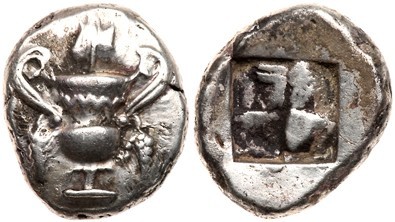AC 208 - Naxos, silver, staters (520-470 BCE) Nicolet-Pierre
From SILVER
520 BCE - 470 BCE Silver 13,978 kg
Description
| ObverseInscription or printing placed on the obverse.: | Kantharos with grape bunch hanging from each handle, above, ivy leaf. |
| ReverseInscription or printing placed on the reverse.: | Quadripartite incuse square. |
Mint and issuing power
| MintIdentifies the place of manufacture or issue of a numismatic object.: | Naxos | Ancient regionAncient region.: | Cyclades | Modern countryModern country: Greece | AuthorityIdentifies the issuing power. The authority can be "pretended" when the name or the portrait of X is on the coin but he/she was not the issuing power. It can also be "uncertain" when there is no mention of X on the coin but he/she was the issuing power according to the historical sources: |
Chronology
| FromIdentifies the initial date in a range assigned in a numismatic context. | 520 BCE | toIdentifies the final date in a range assigned in a numismatic context.. | 470 BCE | PeriodTime period of the numismatic object.: Archaic until 480 BC |
Physical description
| MetalThe physical material (usually metal) from which an object is made.: | Silver |
Median weightMedian of the weights of numismatic objects (in grams). in grams | 12.30 | DenominationTerm indicating the value of a numismatic object. Examples: tetradrachm, chalkous, denarius.: | stater |
StandardStandard.: |
Image

AC208 Naxos.jpg [1]
References
| Die study referencePublication of the study: | Nicolet-Pierre 19971Nicolet-Pierre 1997 | ||
| Coin series referenceReference to coin series study: | Sear I2Sear I, n° 3057, RQEMAC3RQEMAC, n° 208, HGC 64HGC 6, n° 624 | ||
Obverse dies distribution
| FrequencyFrequency of specimen in distribution. ᵖ | Number of obversesNumber of obverse dies. ᵖ (o) | % (o) | Number of coinsNumber of coins. (n) | % (n) | Die nameName(s) of the die(s). |
| 1 | 19 | 54.29 | 19 | 27.14 | 4, 7, 10, 11, 14, 18, 19, 20, 22, 23, 24, 25, 26, 27, 28, 29, 32, 34, 35 |
| 2 | 8 | 22.86 | 16 | 22.86 | 2, 3, 6, 12, 15, 21, 31, 33 |
| 3 | 4 | 11.43 | 12 | 17.14 | 13, 16, 17, 30 |
| 5 | 2 | 5.71 | 10 | 14.29 | 1, 9 |
| 6 | 1 | 2.86 | 6 | 8.57 | 5 |
| 7 | 1 | 2.86 | 7 | 10 | 8 |
| Total | 35 of 35 | 100.01 | 70 of 70 | 100 |
Reverse dies distribution
no distribution is available
Quantification
| Number of obversesNumber of obverse dies. ᵖ (o) | 35 | Number of singletons (o1)The number of singleton coins. ᵖ | 19 |
| Number of reverse diesNumber of reverse dies. (r) | 48 | Number of coinsNumber of coins. (n) | 70 |
| Coins per obverse dieNumber of coins per obverse die. (n/o) | 2 | Coins per reverse dieNumber of coins per reverse die. (n/r) | 1.46 |
| Reverse per obverse ratioRatio of obverse dies divided by reverse dies. (r/o) | 1.37 | Percentage of singletons (o1)number of coins (n) divided by the number of singletons (o1) ᵖ | 54.29 % |
| Original number of dies (O) (Carter 1983 formula)The estimation of the number of coins according to Carter 1983 ᵖ | 56.82 | Coins struck if 20,000 as average productivity per dieCoins made if the average productivity for obverses (according to Carter) is 20,000. ᵖ | 1,136,400 |
| Original number of dies (O) (Esty 2011 formula)The estimation of the number of coins according to the singleton formula in Esty 2011 ᵖ (O) | 70 | Survival rate if 20,000 as average productivity per dieSurvival rate if average productivity is 20,000. ᵖ | 0.00006 |
| Coverage (o = % of O) (Esty 1984 formula)Esty 1984 - coverage (% of O) ᵖ (o = % of O) | 72.86% | Die productivity if survival rate 1/2,000Average productivity if survival rate is 1/2,000. ᵖ | 2,463.92 |
| Weight of silver (in kg) if 20,000 coins per die (O = Carter formula)Carter 1983 * Median weight * 20000 (*10 if gold or electrum) ᵖ | 13,978 kg <br /> 13,978 kg | Die productivity if survival rate 1/5,000Average productivity if survival rate is 1/5,000. ᵖ | 6,159.8 |
Remarks